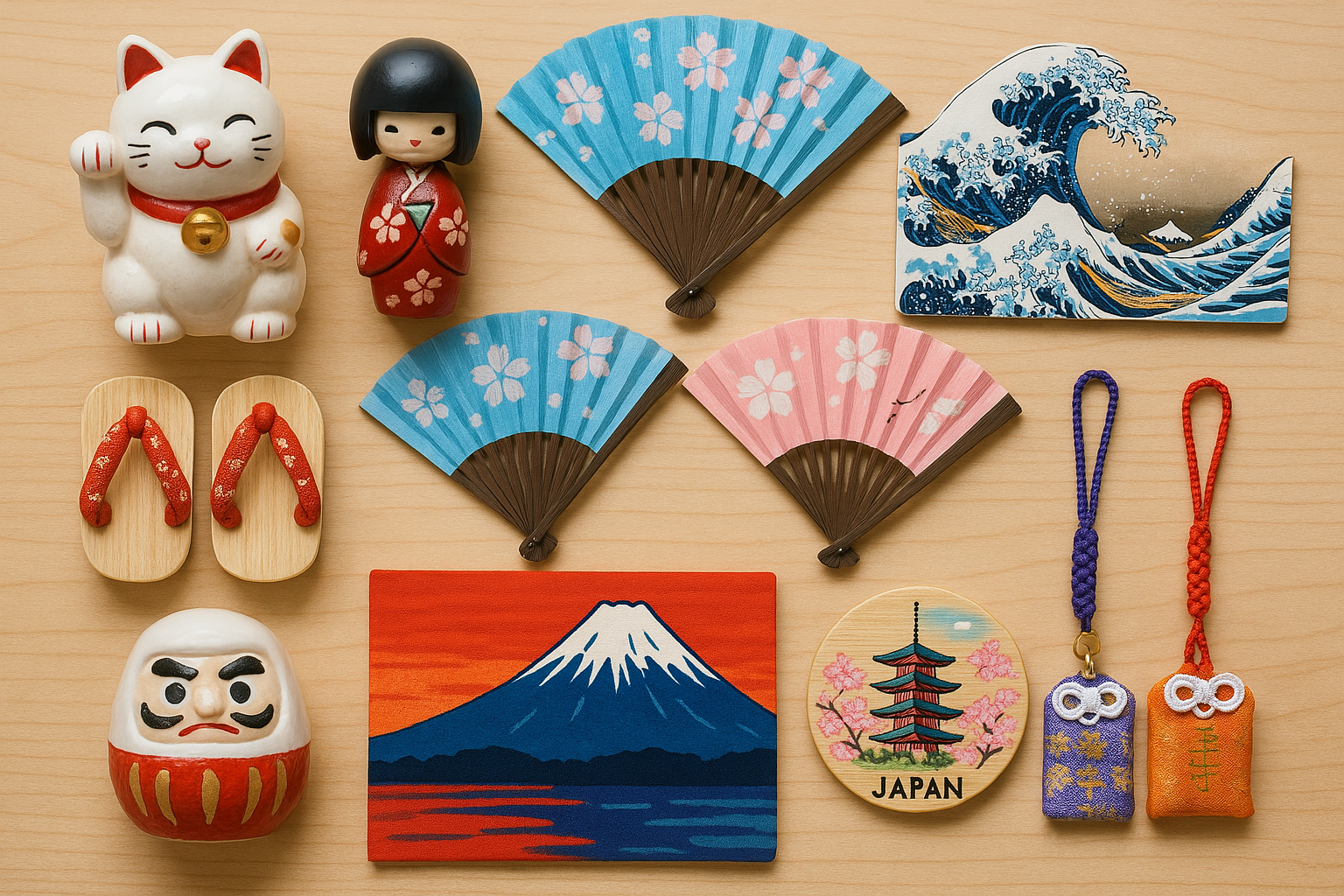Top 15 Japanese Cultural Souvenirs You Shouldn’t Miss in Kyoto: Must-Have Treasures for Your Japan Adventure
- Introduction: Why Kyoto is a Souvenir Hunter’s Paradise
- 1. Kiyomizu-ware Pottery: A Timeless Kyoto Tradition
- 2. Furoshiki: The Versatile Japanese Wrapping Cloth
- 3. Kyoto Yatsuhashi: A Sweet Taste of Kyoto
- 4. Nishijin-ori Textiles: The Fabric of Kyoto’s Tradition
- 5. Kyoto Hand Fans: A Cool and Elegant Souvenir
Introduction: Why Kyoto is a Souvenir Hunter’s Paradise
Kyoto is a treasure trove for anyone looking to bring home a piece of Japan’s rich history and culture. Known for its centuries-old temples, stunning gardens, and traditional crafts, Kyoto is the perfect place for souvenir shopping. Whether you’re a history buff, an art lover, or a foodie, Kyoto offers souvenirs that cater to every interest. From elegant textiles to delicious sweets, the souvenirs here are not just items – they’re experiences in themselves. So let’s dive in and explore 15 must-have souvenirs you should grab before you leave this enchanting city!
1. Kiyomizu-ware Pottery: A Timeless Kyoto Tradition
If you want a souvenir that’s as timeless as Kyoto itself, look no further than Kiyomizu-ware pottery. Named after the famous Kiyomizu Temple, this porcelain pottery has been crafted in Kyoto for centuries. The soft, soothing colors and smooth, delicate finishes make each piece unique. If you’ve ever been to a Japanese tea ceremony or seen a traditional Japanese dinner setting, you’ve likely seen Kiyomizu-ware in action. Whether you’re getting a teacup, a small bowl, or a vase, this pottery will bring a bit of Kyoto’s serenity to your home. Plus, it’s a conversation starter! You can tell your friends, “Oh, this little bowl? Just a piece of Kyoto history!”
What is Kiyomizu-ware?
Originating from the area around Kiyomizu Temple, Kiyomizu-ware is known for its simple yet sophisticated designs. It typically features soft pastel colors, and each piece is carefully crafted by hand, which makes every item a unique masterpiece. Traditionally, Kiyomizu-ware was used for tea ceremonies, but it’s now popular for decorative purposes and everyday use.
Why You Should Buy Kiyomizu-ware
Not only will you take home a piece of Kyoto’s ancient tradition, but you’ll also own something practical. These pieces are made to last, and their understated elegance will elevate any table setting. Plus, they’re lightweight and easy to pack – so no worries about breaking them in your suitcase! If you’re after a meaningful, beautiful souvenir, Kiyomizu-ware is a top choice.
2. Furoshiki: The Versatile Japanese Wrapping Cloth
If you’ve ever struggled to wrap a gift or thought wrapping paper was a waste of resources, Furoshiki is about to become your new best friend. Furoshiki is a traditional Japanese wrapping cloth that has been used for centuries for everything from carrying groceries to wrapping gifts. But here’s the twist: it’s not just functional – it’s an art form! These beautiful cloths come in various patterns, from floral to geometric, and can be used for just about anything. If you need a practical souvenir that’s also stylish and eco-friendly, Furoshiki is perfect.
The History of Furoshiki
Originally, Furoshiki was used to carry belongings and even clothing. It was designed for functionality, and its use spread across Japan, especially during the Edo period. Today, it’s considered both a traditional craft and a modern accessory, often used in everyday life and by people who value sustainability.
How to Use Furoshiki
The best thing about Furoshiki is its versatility. You can use it to wrap a bottle of sake for a friend, carry your lunch, or even turn it into a chic handbag. It’s like a magical cloth that transforms to suit your needs. And the best part? It’s reusable, making it a great alternative to single-use wrapping paper. You’ll feel proud every time you use it – and your friends will ask, “Where did you get that stylish bag?”
3. Kyoto Yatsuhashi: A Sweet Taste of Kyoto
No trip to Kyoto is complete without trying Yatsuhashi, a traditional sweet that’s as famous as the city’s temples. Made from rice flour, sugar, and cinnamon, Yatsuhashi is a chewy, cinnamon-scented treat wrapped in a soft, translucent skin. The beauty of this treat lies in its simplicity. It’s a sweet that reminds you of Kyoto’s quiet charm. You’ll find it in almost every souvenir shop, but the best ones are often sold by specialty stores that have been perfecting the recipe for generations.
What is Yatsuhashi?
Yatsuhashi is a Japanese sweet made from glutinous rice flour, sugar, and a touch of cinnamon. It’s often eaten as a dessert or enjoyed with green tea. The “raw” variety is chewy, while the “baked” version is crisp and more like a cookie. The raw Yatsuhashi is what most people love to take home as a souvenir, as it’s a true reflection of Kyoto’s sweet side.
Different Varieties of Yatsuhashi
There are two main types of Yatsuhashi: raw and baked. The raw version is soft and chewy, with a delicate texture that melts in your mouth. The baked version is more like a crunchy cookie with a slightly caramelized taste. The raw variety is often filled with sweet red bean paste or matcha-flavored filling, adding a little extra Kyoto flair. It’s the kind of treat that pairs perfectly with a cup of Kyoto’s famous matcha tea.
4. Nishijin-ori Textiles: The Fabric of Kyoto’s Tradition
When you think of Kyoto, you might picture kimonos. And for good reason – Kyoto is home to one of Japan’s most famous textiles: Nishijin-ori. This traditional weaving technique, dating back to the 8th century, is known for its luxurious beauty and intricate patterns. It’s used for everything from high-end kimonos to stylish accessories, making it a top souvenir choice for those wanting a truly unique piece of Kyoto craftsmanship.
What is Nishijin-ori?
Nishijin-ori is a type of brocade weaving that originated in the Nishijin district of Kyoto. This technique involves weaving silk threads into intricate patterns, often featuring traditional Japanese motifs like flowers, birds, and geometric shapes. The result is a fabric that’s both beautiful and durable, making it perfect for high-end garments and accessories.
Why You Should Purchase Nishijin-ori
If you’re looking for a truly luxurious souvenir, Nishijin-ori is the way to go. Whether you’re buying a scarf, a kimono, or even a small accessory like a clutch bag, the intricate patterns and shimmering silk will make you feel like royalty. It’s a high-quality souvenir that captures Kyoto’s timeless elegance and craftsmanship.
5. Kyoto Hand Fans: A Cool and Elegant Souvenir
History of Kyoto Fans
Kyoto’s hand fans have a long and storied history, dating back to the Nara period (8th century). The fans were used by aristocrats, samurai, and dancers, and their design evolved over the centuries to become the elegant, lightweight fans we know today. Kyoto fans are still handmade by skilled artisans who have passed down their craft for generations.
Types of Kyoto Fans
There are two main types of Kyoto fans: folding fans (sensu) and non-folding fans (uchiwa). Folding fans are often used in traditional tea ceremonies, festivals, and dance performances. Non-folding fans are popular for decorative purposes and are often seen in homes as part of the decor. Both types are beautiful, functional, and embody the elegance of Kyoto’s culture.






コメント